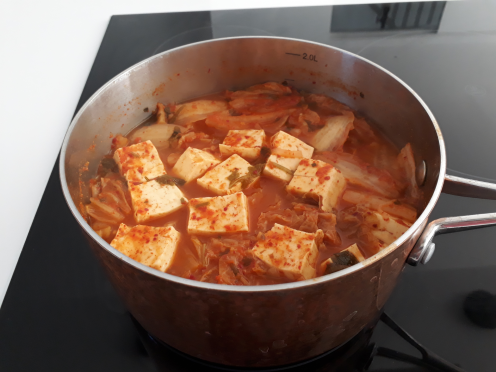In Korea if there is No Kimchi, then there is No meal!
For breakfast, lunch and dinner all year round it is on your dining table.
This means that a Kimchi refrigerator is a key appliance in Korean homes. I haven’t yet seen someone who hasn’t got one in their house.
Kimchi is the staple food in Korean cuisine.
It is made of fermented vegetables with a variety of different spices.
As Kimchi gets older, fermentation creates the different levels of flavour; at the beginning for the first 2-3 days, it is salty and spicy but as time goes on it produces a vinegary sharpness and the spiciness becomes milder and even sweet. Therefore, old Kimchi is the best ingredient for use in Korean stews, soups, stir fry, pancakes and spring rolls.
The most common ingredient of Kimchi is white Korean cabbage (Baechu) 배추. In the UK Chinese cabbage (Chinese leaves) are less firm, more watery and lighter (around 500-600 g) in comparison to the denser Korean cabbage (weighing around 3 kgs.)
Koreans often add fish sauce, fresh fish or oysters as ingredients of Kimchi depending on the region. This has its pros and cons. For example, Seoul people tend to make Kimchi without any fish sauce so when their Kimchi starts to ferment, the taste is very sour and it can only be kept for a short period. Whereas using fish sauce acts as a preservative and ensures the classic taste.
If you do not need to keep your Kimchi for more than few weeks then I would recommend that do not use any fish sauce.
If you are a Vegan then Kimchi will be a key starting place for exploring for other Korean dishes.
There are about 100 different varieties of Kimchi but typically people will keep the kimchi around 6-10 different Kimchi in their Kimchi refrigerator.
There is no doubt that Baechu Kimchi배추김치 has a deeper flavour and a better texture and you can keep it much longer.
Let me introduce some different Kimchi.
- Baechu Kimchi (배추김치): “Whole Cabbage Kimchi” generally when we simply say kimchi we mean this type.
- Dongchimi (Radish Water Kimchi): “Winter Kimchi”, big Korean white radish
- Baek (White) Kimchi: without chillies,
- Ggakdugi Kimchi (깍두기): “Chopped Radish Cubes”, Korean white radish but I always make it with Kohlrabi that actually approximates to the best quality Korean white radish.
- Yeolmumul Kimchi (열무물김치): “Green Water Kimchi”, Tokyo turnips in UK
- Nabak Kimchi (나박김치): “Red Water Kimchi”, Korean white radish
- Chonggak Kimchi (총각김치): “Whole Radish Kimchi or Ponytail Kimchi”, a little bigger than Tokyo turnips in UK
- Gat Kimchi: “Mustard Leaf Kimchi”, similar to Tat Soi with horseradish taste. I have made with Tat Soi. It is very similar to Gat Kimchi and this is from the southern provinces where I went to learn regional Kimchi. This is good with pork BBQ.
- Mak Kimchi (막김치): “Summer Kimchi”
- Oi Sobagi (오이김치): “Cucumber Kimchi”, this keeps only a few days.
- Kkaennip Kimchi (깻잎): ”Perilla Leaf Kimchi”, my best favourite. It is the best with BBQ
- Spring onion Kimchi






Thank you for the idea!! Add it to the list of things to try with tofu 😀
It is also good with Korean Soju as Anju (alcohol with food).
What ?
Thanks for visiting despite I haven’t up dated for a long time. There are many tofu dishes either temple or home dishes and I will try to up date more dishes from now on and sorry too late to reply you